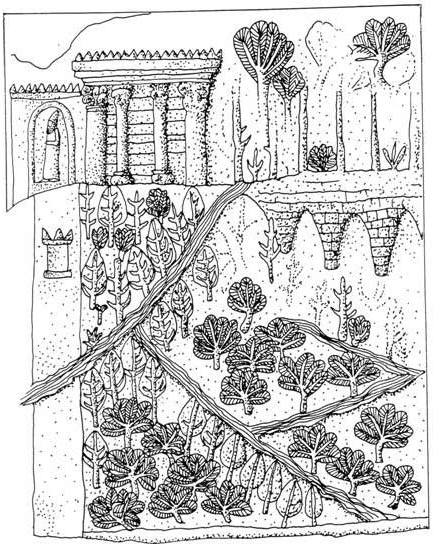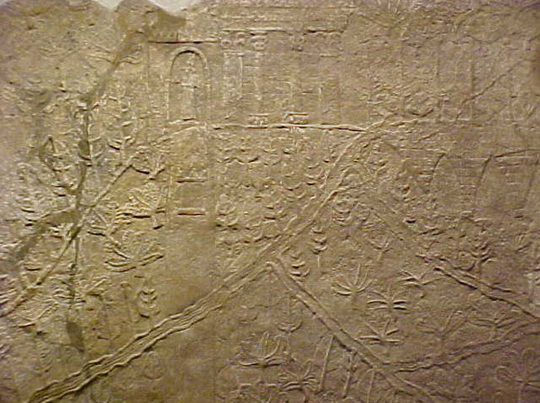The find of a 2700 year old garden in Ramat Rachel just south of Jerusalem is spectacular enough to get the imagination going. Luckily for us the garden was well preserved, that is: the irrigation canals and foundations of buildings surrounding the garden. Scientists will do various soil and pollen research in order to find out which plants grew here.
The result of their ongoing research might tell us more about the similarities and differences between this garden in modern day Israel and Mesopotamian gardens from around the same date. Mesopotamian gardens from the Assyrian kings Sargon II (721-705 BC) and Sennacherib (704-681 BC) in and near Nineveh (near modern day Mosul, Iraq) could have greatly influenced the layout of this Ramat Rachel garden. Lying in Judah, Ramat Rachel became part of a vassal kingdom of Assyriah in the 7th century BC, around the time these Mesopotamian gardens were at their prime. But the differences must have been large as well, knowing that both places lie some 900 kilometers apart. I’m very curious what the archaeologists will find.
The Unknown
An intriguing insight into the way the garden looks to the archaeologists is presented by Boaz Gross from Tel Aviv university, as presented on the LiveScience.com website (click image to enlarge). We see different kinds of trees within an enclosed space. There is water supply by what seems to be some sort of aqueduct supported by arches, letting the water run into and through the garden through irrigation channels.
 But this drawing is intriguing not because what it tells us about the garden. For instance, it doesn’t give any information about dimensions, territory, about the organisation of plants, nor does it tell us what the paths looked like or -bar one- where they were.
But this drawing is intriguing not because what it tells us about the garden. For instance, it doesn’t give any information about dimensions, territory, about the organisation of plants, nor does it tell us what the paths looked like or -bar one- where they were.
It intrigues because of the way it looks.
The Representation
Neo-Assyrian bas relief in the British Museum (645-635 BC, reg.nr. 1856,0909.36). probably Possibly a representation of the Hanging Gardens.
The drawing immediately sprung out because it does not show what the garden looks like, it shows how a garden would have been represented in ancient times. And I was impressed. Because it is very difficult to draw something you have no first hand impression of, and not make it look like something produced in your own day, like something remotely familiar to you. 1The quite detailed description of Pliny’s garden near Rome has inspired artists in the 17th and 18th century to draw plans of that garden, based on the description alone; and every plan is more telling of the garden style in the artists time than of Pliny’s garden.
And then I found it: the drawing of what the Ramat Rachel garden may have looked like, is an almost exact copy of a bas relief now kept in the British Museum (including the man standing in a doorway, wearing a pointy hat). The relief is believed to be a representation of the Hanging Gardens of Babylon, or of gardens similar to these. Researchers now believe these hanging gardens were located in Nineveh.
Which makes it a very appropiate illustration, given the ties between the regions, but not a representation of what the Ramat Rachel garden may have looked like (let alone an ‘artistic impression‘). The archaeologist knew that, the science websites missed it.
Like I said: I’m very curious to see what the archaeologists will find.
Footnotes
| ↑1 | The quite detailed description of Pliny’s garden near Rome has inspired artists in the 17th and 18th century to draw plans of that garden, based on the description alone; and every plan is more telling of the garden style in the artists time than of Pliny’s garden. |
|---|



